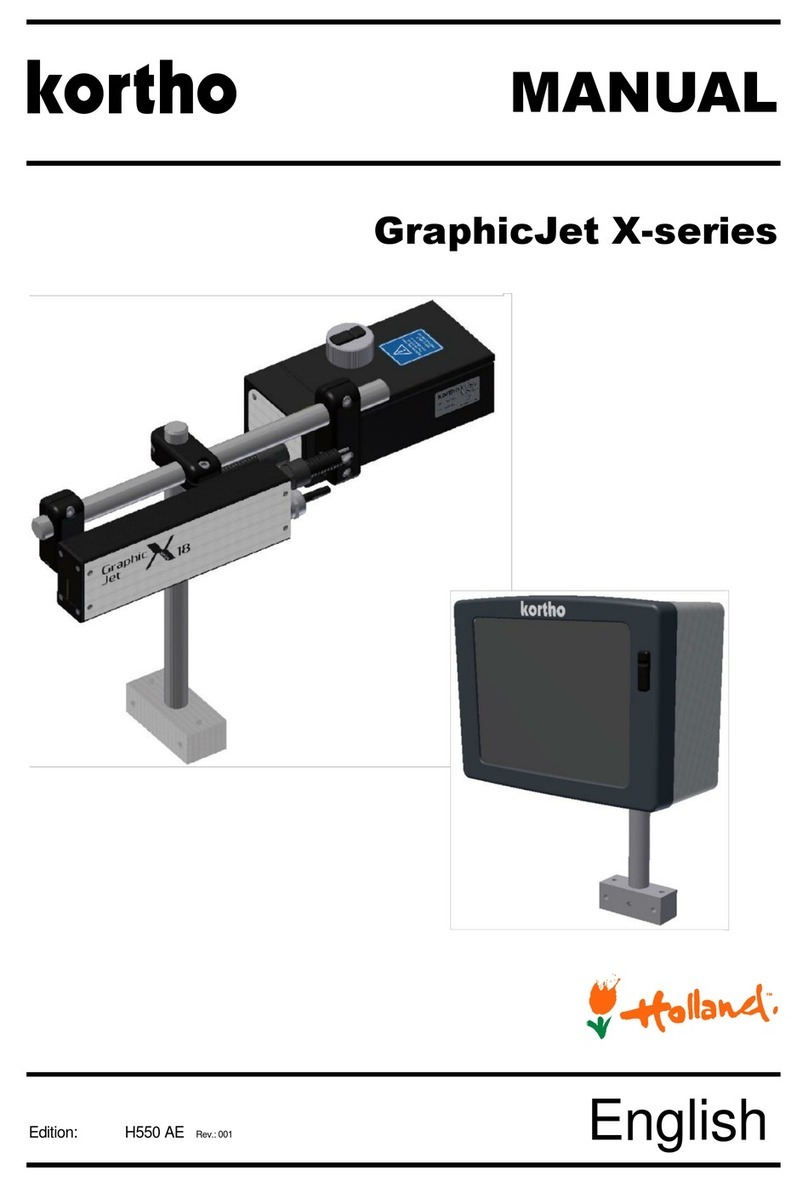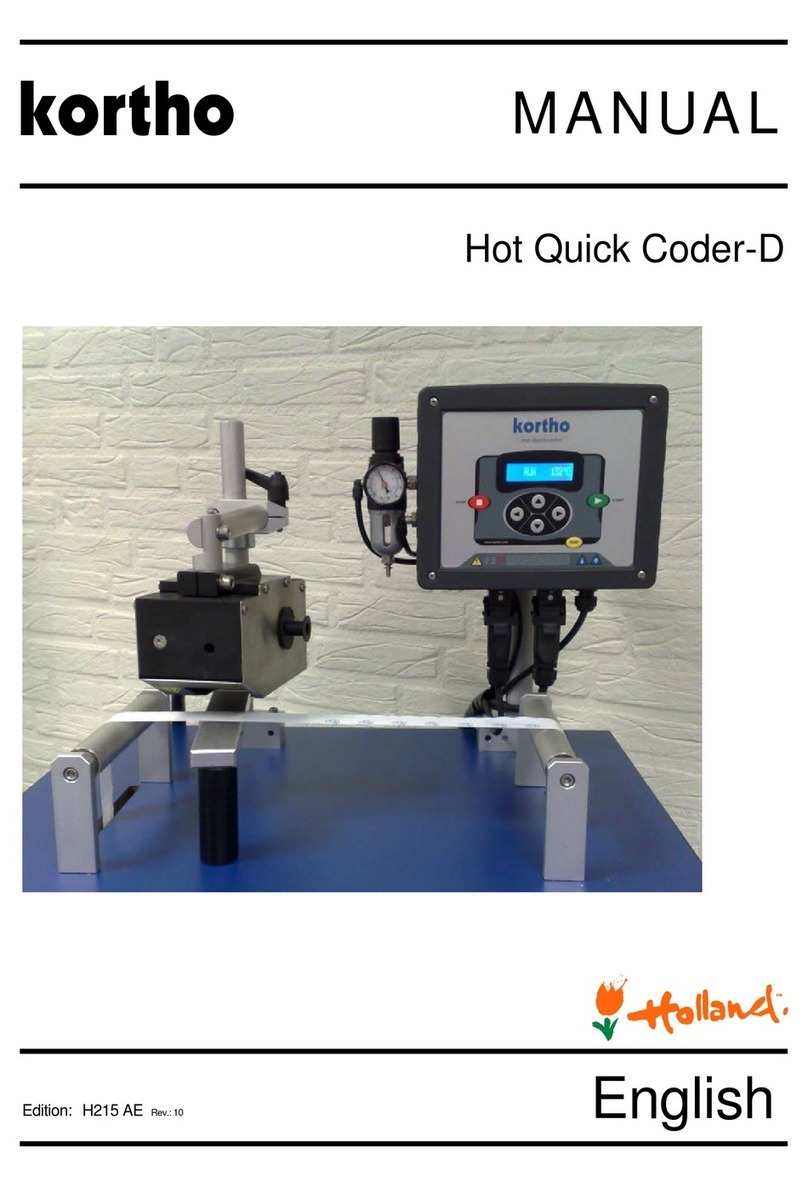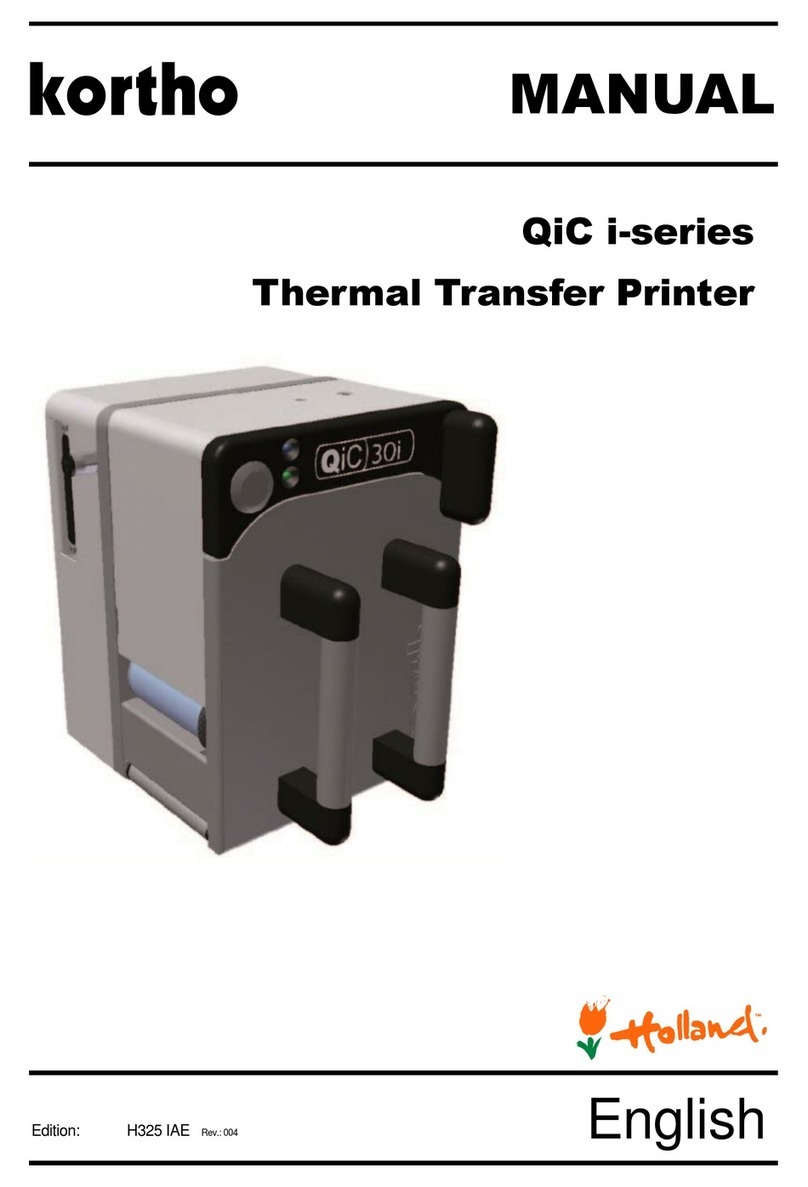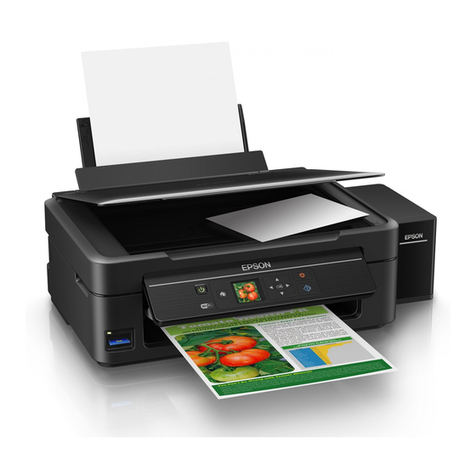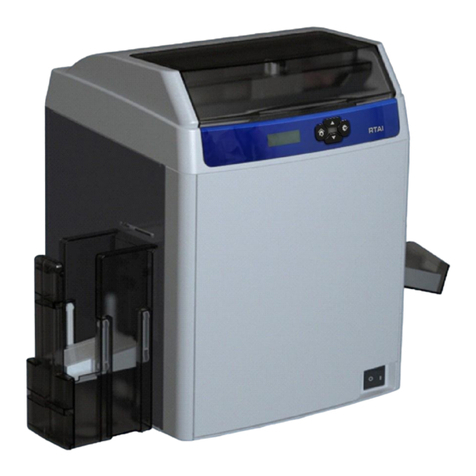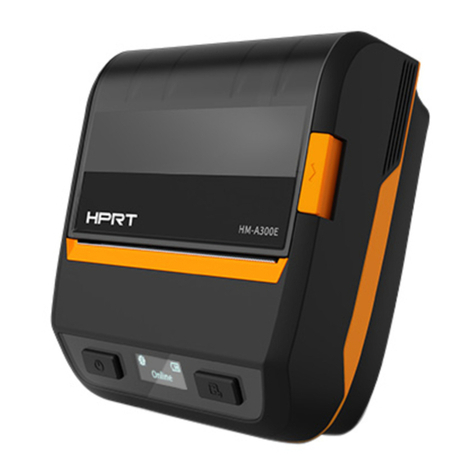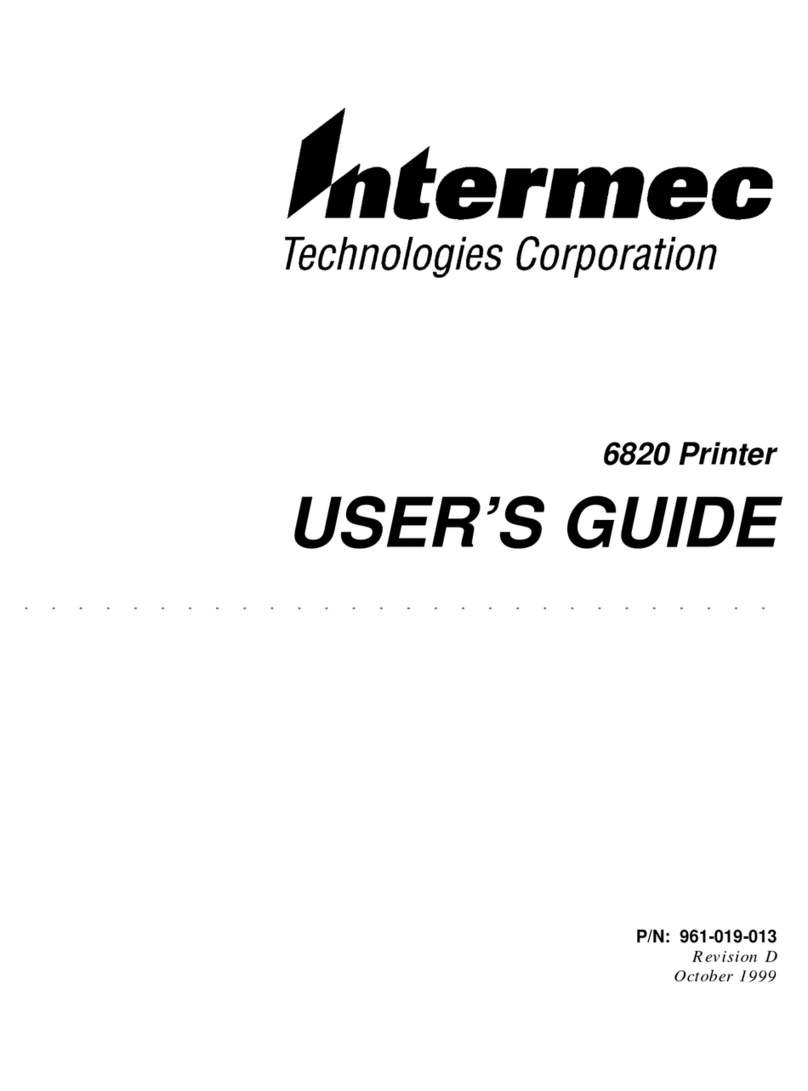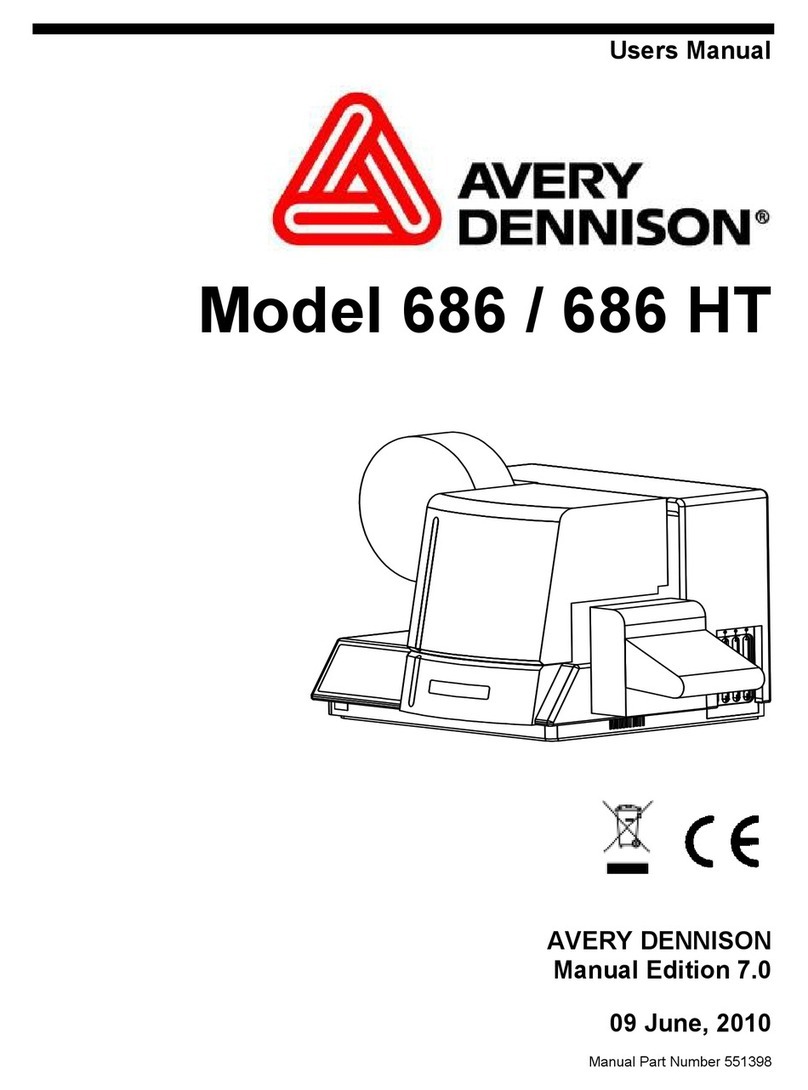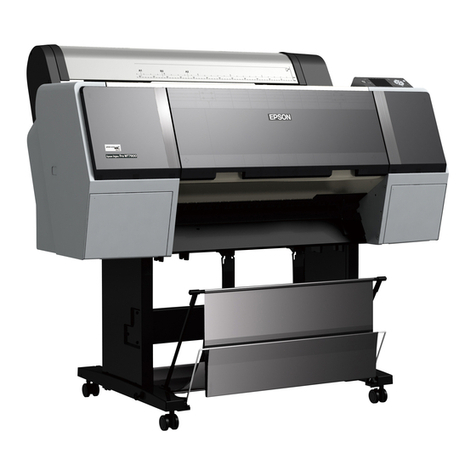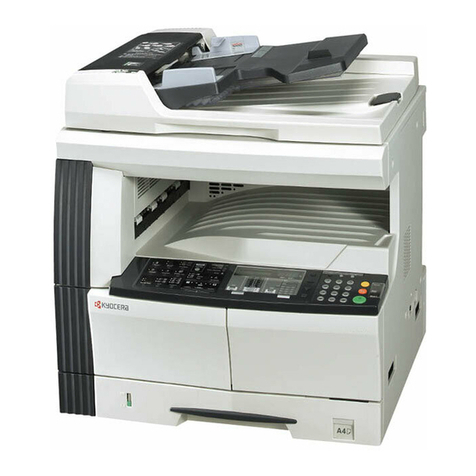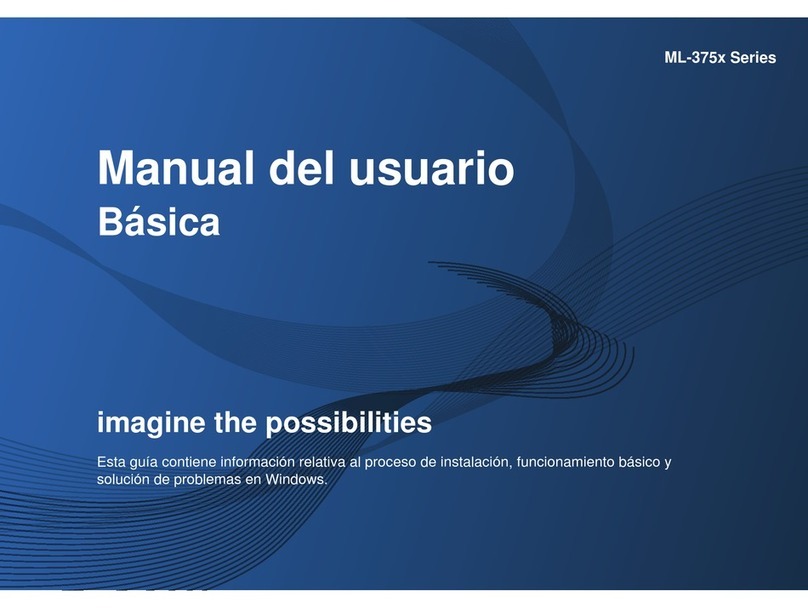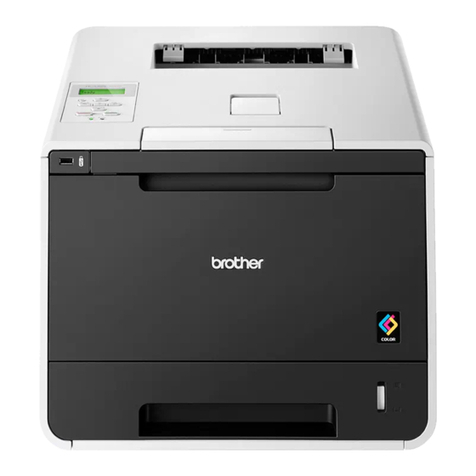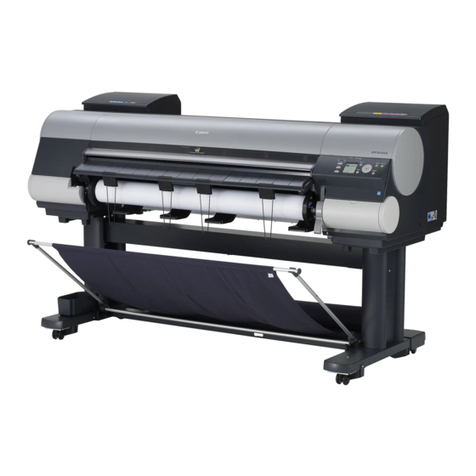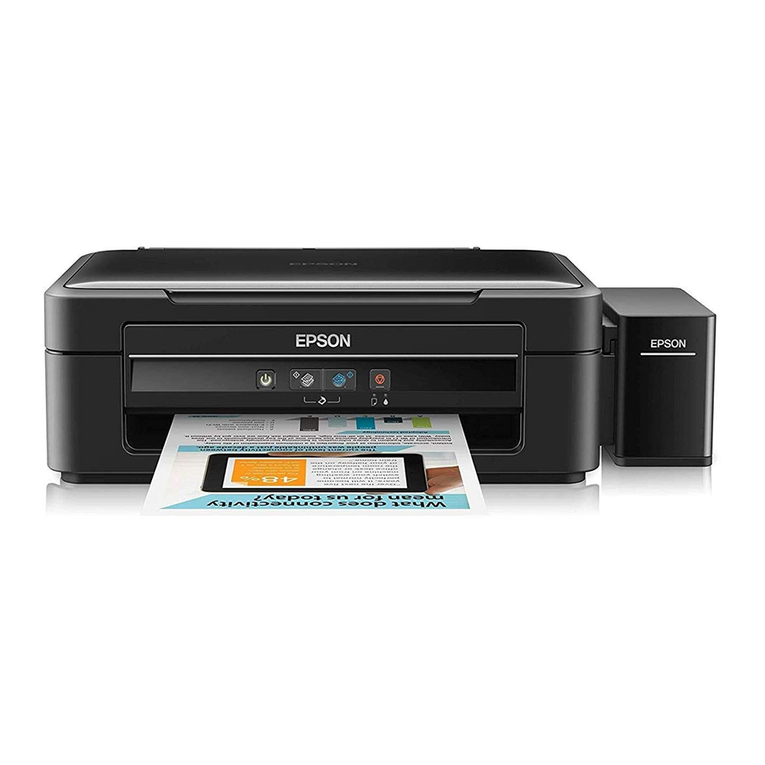Kortho GraphicJet X Series User manual

MANUAL
GraphicJet X-series
Edition: H550 AE Rev.:007
English
kortho

kortho KGJ X-series H550 AE Rev.: 007
ii
bv korthofah
P.O. box: 3040
2220 CA, Katwijk
The Netherlands
Tel: +31 71 40 60 480
Fax: +31 71 40 32 807
E-mail: export@kortho.nl
Internet: www.kortho.com,www.kortho.eu
Document date: 16/08/2019
Manual: H550 AE KGJ TSC20 EN 006.doc
Number of pages: 236
The basis for this manual is:
Series: KGJ X-series
Production year: 2016 - 2018
Original language: English
Standard models: KGJ X18 / X18+ / X18si / X54 / X72 series + TsC20-X / TsC20-X duo
QiC Control version: V1.0-06032018a
Copyright
©
2019 bv korthofah
All Rights Reserved
The kortho logo and the bv Korthofah logo are trademarks of Korthofah BV. All other brand and product
names in this manual are the trademarks or registered trademarks of their respective holders.
Printed in the EC 2019
In light of continuous development and improvement, Korthofah BV reserves the right to modify the
specifications without prior notice. The figures printed in this manual may slightly differ from the Kortho
GraphicJet. Information in this document is subject to change without notice.
No part of this document may be reproduced or transmitted in any form or by any means, electronic or
mechanical, without the written permission of Korthofah BV.

H550 AE Rev.: 007 kortho KGJ X-series
iii
▪Preface
Welcome to the GraphicJet X-series manual.
Read the manual before you start and read it carefully. This will avoid unnecessary problems and loss of
performance.
This manual is meant for all personnel who are involved with the GraphicJet X-series, which includes the
control units TsC20-X and TsC20-X duo and the coding units X18, X18+, X18si, X54 and X72. The purpose of
this manual is to get familiar with the GraphicJet X-series. This involves operational, safety, transport &
storage, installation, commissioning, fault diagnosis and maintenance instructions.
The general construction for the different types of coding units of the GraphicJet X-series is the same.
Because of this there is no need to show pictures of each individual model. Functions which are typical for a
particular control unit and/or coding unit will be marked by the type identification between brackets e.g.
[TsC20-X duo] if the function is only available for the Control unit TsC20-X duo or [X72] if the function is not
available for the coding unit X72.
All personnel must read the first four sections named INTRODUCTION, TECHNICAL DESCRIPTION,
PRINT PROCESS DESCRIPTION and SAFETY. The other sections provide instructions or information for
different aspects of the GraphicJet X-series.
Keep this manual on a sensible and safe place for future use.
Contact Korthofah BV or your local distributor if you have any questions.
Conventions in this manual:
▪The GraphicJet X-series will be referred to as the printer.
▪Any material the printer is used to print on is called substrate.
▪The customer is the person or company who is the owner of the printer.
▪Follow the instruction order as indicated when you carry out any of the procedures described.
Instruction format:
1. Instruction. Comment(s).
a. Sub-instruction. Comment(s).
b. Sub-instruction. Comment(s).
2. Instruction. Comment(s).
▪Symbols in this manual
In this manual, the following symbols are used:
WARNING:
This symbol indicates a potentially hazardous situation which, if instructions are not followed,
could result in death or serious injury.
CAUTION:
This symbol indicates a potentially hazardous situation which, if instructions are not followed, may
result in minor or moderate injury or damage to property.
The statements above are notes for your safety.
Beware:
A notice with useful information for the user in relation to the product. It attends the user to
possible problems.

kortho KGJ X-series H550 AE Rev.: 007
iv
Note:
Gives the user suggestions and helps the work to be carried more rapidly.
▪Glossary
Bitmap: A data file or structure. A set of bits that represents a graphic image, with each bit
or group of bits corresponding to a pixel in the image.
Datum: Drawing term for a fixed reference point from which measurements are taken.
Encoder: This is a shaft encoder. It converts shaft rotations to pulses for accurate and precise
measurements. The encoder generates pulses from which the control unit can
extract the product speed information in order to match the print speed.
Host: A machine or production system that handles the product or substrate and can be
connected by an interface to the printer, e.g. a printer alarm to stop the machine.
Label: A design file from which the printer generates the bitmap to print. This design file
can contain a unique combination of text, numeric, date, time, barcode and/or
graphical items.
Label memory: Memory on the CPU board in which the labels, fonts and graphics can be stored.
From this memory labels can be selected for printing (stored in the printlab
memory).
Nozzle: A narrow piece attached to the end of a tube so that the liquid that comes out can
be directed in aparticular way. In this case a small hole in a nozzle plate. The
printhead comprises an array of channels containing ink. Ink droplets are ejected
from a nozzle at the end of each channel as a result of pressure waves generated in
the ink by deflection of the channel walls.
Nozzle plate: A polymer film in which the nozzles are formed.
Pixel: A pixel is the smallest portion of a bitmap. For a printer one pixel represents one
dot.
Print: The result of printing a label on a substrate.
Print memory: Memory on the CPU board in which the label that one likes to print will be stored.
Print request: A signal generated by a sensor or host machine. It is a trigger to start a print cycle.
Print cycle: The moment from which the printer accepts a print request until the printer is
ready to accept a new print request.
Product: In this manual, the substrate the printer prints on, e.g. a box, package etc.
Sensor: A product detection device connected to the control unit, usually a photocell.
Substrate: This is the material of a product to print on, e.g. cardboard, wood, paper, and
packaging foil.
i

H550 AE Rev.: 007 kortho KGJ X-series
v
▪Table of contents
▪Preface..................................................................................................................................iii
▪Symbols in this manual.........................................................................................................iii
▪Glossary................................................................................................................................iv
▪Table of contents ...................................................................................................................v
1INTRODUCTION
1.1 Qualified personnel............................................................................................................ 1-1
1.2 Elementary personal protection......................................................................................... 1-1
1.3 Intended Use ..................................................................................................................... 1-1
1.4 Specifications..................................................................................................................... 1-2
1.4.1 Coding unit ....................................................................................................... 1-2
1.4.2 Control unit....................................................................................................... 1-3
1.4.3 Ink..................................................................................................................... 1-4
1.4.4 Label features................................................................................................... 1-4
1.4.5 Life span........................................................................................................... 1-5
1.4.6 Electrostatic charge.......................................................................................... 1-5
1.4.7 Shock & vibration ............................................................................................. 1-5
2TECHNICAL DESCRIPTION
2.1 The print system................................................................................................................ 2-1
2.2 Coding unit......................................................................................................................... 2-2
2.3 Control unit......................................................................................................................... 2-3
2.4 Sensors.............................................................................................................................. 2-5
2.4.1 Photocell........................................................................................................... 2-5
2.4.2 Encoder............................................................................................................ 2-5
2.5 Label design ...................................................................................................................... 2-6
2.5.1 Integrated label design program ...................................................................... 2-6
2.5.2 NiceLabel ......................................................................................................... 2-6
3PRINT PROCESS DESCRIPTION
3.1 Print cycle .......................................................................................................................... 3-1
3.2 Printhead............................................................................................................................ 3-1
3.3 Ink system.......................................................................................................................... 3-2
3.4 Spit function....................................................................................................................... 3-2
3.5 User interface .................................................................................................................... 3-3
3.5.1 Menu structure ................................................................................................. 3-3
3.5.2 LED indicators on control unit .......................................................................... 3-3
3.5.3 Keyboard.......................................................................................................... 3-4
3.5.4 System information........................................................................................... 3-8
3.5.5 Menu structure ................................................................................................. 3-9
4SAFETY
4.1 General.............................................................................................................................. 4-1
4.2 Control unit......................................................................................................................... 4-1
4.2.1 General information.......................................................................................... 4-1
4.2.2 Power supply.................................................................................................... 4-2
4.2.3 Precautions before power-up........................................................................... 4-2
4.2.4 Precautions when opening the control unit...................................................... 4-3

kortho KGJ X-series H550 AE Rev.: 007
vi
4.3 Anti-static precautions........................................................................................................4-3
4.3.1 Printhead ..........................................................................................................4-3
4.3.2 Printed circuit boards........................................................................................4-3
4.4 Ink and cleaner...................................................................................................................4-4
4.4.1 General safety measures .................................................................................4-4
4.4.2 First aid measures............................................................................................4-4
4.4.3 Warning labels..................................................................................................4-4
4.4.4 Caution labels...................................................................................................4-4
5TRANSPORT & STORAGE
5.1 Printer equipment...............................................................................................................5-1
5.1.1 Shipping and handling......................................................................................5-1
5.1.2 Pre-transport procedure ...................................................................................5-1
5.1.3 Pre-storage procedure......................................................................................5-2
5.2 Ink and cleaner...................................................................................................................5-4
5.2.1 Handling and storage .......................................................................................5-4
5.2.2 Transport information .......................................................................................5-4
6INSTALLATION
6.1 Requirements.....................................................................................................................6-1
6.1.1 Provided by the customer.................................................................................6-1
6.1.2 Equipment.........................................................................................................6-1
6.1.3 Optional parts ...................................................................................................6-1
6.2 Unpacking..........................................................................................................................6-2
6.2.1 Coding unit........................................................................................................6-2
6.2.2 Control unit .......................................................................................................6-3
6.2.3 Encoder (Optional) ...........................................................................................6-3
6.2.4 Ink set...............................................................................................................6-4
6.3 Coding unit mounting options ............................................................................................6-4
6.3.1 Distance between front plate and product........................................................6-4
6.3.2 Ink reservoir......................................................................................................6-5
6.3.3 Ink reservoir orientation....................................................................................6-5
6.3.4 Printhead rotation [X54] [X72] ..........................................................................6-6
6.3.5 Radial printhead rotation ..................................................................................6-6
6.3.6 Axial printhead rotation [X54] [X72]..................................................................6-9
6.3.7 Radial and axial printhead rotation [X54] [X72]..............................................6-11
6.4 Positioning the sensors....................................................................................................6-12
6.4.1 Photocell for print request (X04).....................................................................6-12
6.4.2 Photocell to enter BCD code into the buffer (X08).........................................6-12
6.4.3 Encoder (optional) ..........................................................................................6-13
6.5 Mounting the control unit..................................................................................................6-14
7COMMISSIONING
7.1 Preparing the control unit...................................................................................................7-1
7.2 Filling the ink system..........................................................................................................7-2
7.3 Tuning the speed related parameters................................................................................7-5
7.3.1 Preparing for the first test print.........................................................................7-5
7.3.2 Tuning the test print with the encoder disabled................................................7-7
7.3.3 Tuning the test print with the encoder enabled ................................................7-8
7.4 General print parameter settings .......................................................................................7-8
7.4.1 Changing the print direction..............................................................................7-8
7.4.2 Changing the print direction and mirroring the label.........................................7-9
7.4.3 Setting the print request parameters................................................................7-9
7.5Spit parameter settings....................................................................................................7-10
7.5.1 Setting the spit parameters.............................................................................7-10
7.5.2 Setting the ink low and ink out outputs...........................................................7-12

H550 AE Rev.: 007 kortho KGJ X-series
vii
7.6 User settings.................................................................................................................... 7-12
8OPERATION
8.1 Powering up....................................................................................................................... 8-1
8.2 Operational ........................................................................................................................ 8-2
8.2.1 Start printing..................................................................................................... 8-2
8.3 Operator data input............................................................................................................ 8-2
8.3.1 Text item input menu........................................................................................ 8-3
8.3.2 Date advance input menu ................................................................................ 8-4
8.3.3 Number start value input menu........................................................................ 8-4
8.4 Label management............................................................................................................ 8-5
8.4.1 Selecting a label for printing............................................................................. 8-5
8.4.2 List labels (Local files)...................................................................................... 8-6
8.4.3 Add labels......................................................................................................... 8-6
8.4.4 Moving a label .................................................................................................. 8-8
8.4.5 Deleting a label................................................................................................. 8-9
8.4.6 Editing a label................................................................................................. 8-10
8.4.7 Creating a label .............................................................................................. 8-11
8.4.8 Showing a preview ......................................................................................... 8-15
8.5 Re-filling the ink reservoir................................................................................................ 8-16
8.5.1 Purging the printhead..................................................................................... 8-17
8.5.2 Priming the printhead..................................................................................... 8-18
8.6 Adjusting printer settings ................................................................................................. 8-19
8.6.1 System settings.............................................................................................. 8-20
8.6.2 Printer settings ............................................................................................... 8-25
8.6.3 Signal settings................................................................................................ 8-28
8.6.4 Network settings............................................................................................. 8-32
8.6.5 Label settings ................................................................................................. 8-35
8.6.6 Print settings................................................................................................... 8-37
8.7 Specific settings for the TsC20-Duo................................................................................ 8-39
9DIAGNOSTICS / TROUBLESHOOTING
9.1 Service............................................................................................................................... 9-1
9.1.1 Test labels........................................................................................................ 9-1
9.1.2 Fonts................................................................................................................. 9-2
9.1.3 Test................................................................................................................... 9-6
9.1.4 Printer............................................................................................................... 9-8
9.1.5 Diagnostics..................................................................................................... 9-10
9.1.6 Graphics......................................................................................................... 9-12
9.2 Information....................................................................................................................... 9-15
9.2.1 General........................................................................................................... 9-15
9.2.2 Health............................................................................................................. 9-16
9.2.3 Backup............................................................................................................ 9-16
9.2.4 System Info .................................................................................................... 9-18
9.2.5 Report............................................................................................................. 9-19
9.2.6 Upgrade.......................................................................................................... 9-21
9.3 Fault finding ..................................................................................................................... 9-23
9.3.1 Control unit..................................................................................................... 9-23
9.3.2 Coding unit ..................................................................................................... 9-24
9.3.3 Print request sensor ....................................................................................... 9-26
9.3.4 Encoder.......................................................................................................... 9-26
9.4 Error/warning messages.................................................................................................. 9-27
9.5 Poor print quality.............................................................................................................. 9-27
9.5.1 General issues ............................................................................................... 9-27
9.5.2 Often seen print results.................................................................................. 9-29
10 MAINTENANCE

kortho KGJ X-series H550 AE Rev.: 007
viii
10.1 Quick and regular checks ................................................................................................10-1
10.2 Nozzle maintenance ........................................................................................................10-1
10.3 Yearly maintenance .........................................................................................................10-1
10.4 Replacing parts of the printhead housing ........................................................................10-1
10.4.1 Anti-static precautions ....................................................................................10-1
10.4.2 Open the printhead housing...........................................................................10-2
10.4.3 Close the printhead housing...........................................................................10-3
10.4.4 Replacing the printhead PCB [X18, X18si, X18+]..........................................10-3
10.4.5 Replacing the printhead PCB [X54]................................................................10-4
10.4.6 Replacing the printhead PCB [X72]................................................................10-5
10.4.7 Replacing the piezo printhead [X18, X18si, X18+].........................................10-6
10.4.8 Replacing the piezo printhead [X54] ..............................................................10-6
10.4.9 Replacing the piezo printhead [X72] ..............................................................10-7
10.4.10 Replacing the ink filter....................................................................................10-8
10.5 Updating firmware and software......................................................................................10-8
11 DISMANTLING & DISPOSAL
11.1 Dismantling ......................................................................................................................11-1
11.1.1 System............................................................................................................11-1
11.1.2 Ink reservoir....................................................................................................11-1
11.1.3 Printhead housing...........................................................................................11-1
11.1.4 Control unit .....................................................................................................11-1
11.1.5 Sensor devices...............................................................................................11-1
11.1.6 Ink and cleaner...............................................................................................11-2
11.2 Disposal ...........................................................................................................................11-2
11.2.1 Disposal method.............................................................................................11-2
11.2.2 Waste separation............................................................................................11-2
Index
▪Keywords ............................................................................................................................... I
▪Figures ................................................................................................................................. III
Part 1; selecting a label for printing over Ethernet. .........................................................................M-1
Select Label command standard version (Unicode) .........................................................M-1
Select Label command standard version (ANSI) ..............................................................M-2
Select Label command Escape version..............................................................................M-2
Part 2; updating text fields inside the printed label over TCP/IP....................................................M-3
Update text field command; standard version .................................................................M-3
Update text field command; Escape version.....................................................................M-4
Appendices
Appendix A Specifications....................................................................................................A-1
Appendix B Dimensions.......................................................................................................B-1
Appendix C Part lists & illustrations .....................................................................................C-1
Appendix D Connections......................................................................................................D-1
Appendix E NiceLabel driver tutorials..................................................................................E-1
Appendix F Quick reference menu structure.......................................................................F-1
Appendix G Error list ........................................................................................................... G-1
Appendix H Using the BCD label selection..........................................................................H-1
Appendix I Using variables in labels....................................................................................I-1
Appendix J Setting and using the security option ............................................................... J-1
Appendix K Restore factory settings using dipswitch ..........................................................K-1
Appendix L The automation feature ....................................................................................L-1
Appendix M Selecting and updating a label over TCP/IP....................................................M-1
Appendix N Remapping inputs & outputs ............................................................................N-1
Appendix O EC Declaration of conformity........................................................................... O-1

H550 AE Rev.: 007 kortho KGJ X-series
1-1
1 INTRODUCTION
1.1 Qualified personnel
Operators are qualified when they have read and understand sections 1 to 8 of this manual. A specific
preliminary training is not required.
Technicians that carry out repairs and technical maintenance on the printer equipment should have
secondary technical education or comparable technical level of knowledge through practical experience.
Installation or servicing of the printer must only be performed by qualified personnel of Korthofah BV or a
local distributor, which is designated by Korthofah BV.
For customer installations authorisation must be obtained from Korthofah BV or a local distributor, which is
designated by Korthofah BV.
1.2 Elementary personal protection
▪Use the printer only in a well ventilated area.
▪Do not eat or drink while working with the ink or cleaner.
When at risk for contact with the ink or cleaner:
▪Wear chemical resistant gloves.
▪Use safety goggles or face shield in case of splash risk.
▪Wear suitable protective clothing as protection against splashing of or contamination with ink or
cleaner.
When installing of servicing the equipment:
▪Ensure that the host machine is stopped.
▪Ensure the control unit of the printer is switched off.
Please read the SAFETY section and the SDS of the ink used for more information. The SDS can be
downloaded from the Kortho website (www.kortho.com).
1.3 Intended Use
The GraphicJet X-series are industrial printers and are designed to print directly on substrates e.g.
cardboard, wood and paper. The printers can print labels with fixed and/or dynamic items. Dynamic items
are items like operator input text, number, date and time. Beside text related items, the printer can also print
items such as barcodes, shift-codes and graphics.
The labels can be designed with a PC based design tool or they can de designed on the control unit. The
labels designed with a PC based design tool can be downloaded to the control unit by Ethernet or by USB
thumbdrive. The labels will be stored in the label memory.
Beware:
USB must be formatted as FAT12, FAT16, FAT32, exFAT, TexFAT in order to be supported. The
NTFS file system is not supported in any of the Windows CE versions.

INTRODUCTION
kortho KGJ X-series H550 AE Rev.: 007
1-2
Normal use means use under normal conditions as described in this manual i.e. use inks recommended by
Korthofah BV and use only original spare parts.
The printer may not be used in areas which have a fire or explosion hazard.
Korthofah BV does not accept any liability for damage to the equipment or personal injury resulting from
improper use of the equipment or improper maintenance. Neither does Korthofah BV accept any liability for
the normal wear-and-tear of the equipment.
1.4 Specifications
Only general specifications are described in this section. Refer to Appendix A for more detailed
specifications.
1.4.1 Coding unit
Fig. 1.1 Coding units, global dimensions
A general impression of the coding unit dimensions is given in Fig. 1.1. The dimensions (H x W x D, in mm)
(bracket included) and the typical specifications of coding units are:
Part.nr.
Coding unit
Height
Width
Depth
Print area
Print speed
Ink type
817752
Coding unit X18
322
170
477
17,5x1500
0-40m/min
GJ8
818157
Coding unit X18+
322
170
477
17,5x1500
0-60m/min
GJ8
818227
Coding unit X18si
322
170
477
17,5x1500
0-40m/min
GJ4
817555
Coding unit X54
322
183
480
53,7x2000
0-60m/min
GJ8
819041
Coding unit X72
322
190
480
71,8x2000
0-45m/min
GJ9
The ambient temperature must be between 5 °C and 40 °C, with a relative humidity between 10% and 90%
(non-condensing).
Use only Kortho GJ inks and cleaners for this printer. Make sure the ink and cleaner used match.

INTRODUCTION
H550 AE Rev.: 007 kortho KGJ X-series
1-3
1.4.2 Control unit
A general impression of the control unit TsC20 dimensions is given in Fig. 1.2 . The typical specifications of
the control units are:
Part.nr.
Control unit
Height
Width
Depth
Coding unit
818131
Control unit TsC20-X Duo
203
258
153
2
Beware:
One can connect two coding units to the control unit TsC20-X Duo. Both coding units have to be of
the same type, so 2x X18 series, 2x X54-series or 2 x X72-series. Different types of X18 can be used
together.
Fig. 1.2 Control unit, global dimensions
The electrical requirements for the power supply of a Controller TcC20 or TsC20-Duo in combination with
one coding unit X18/X18+/X18si/X54/X72 are:
•Voltage rating: 100-240 VAC;
•Frequency rating: 50 / 60Hz;
•Current rating: 0,5A / 0,25A
•Power rating: 50VAmax.
•Fuse rating: 2x T2,5A 250VAC (slow acting).
The electrical requirements for the power supply of a controller TcC20-Duo in combination with two coding
units X18/X18+/X18si/X54/X72 are:
•Voltage rating: 100-240 VAC;
•Frequency rating: 50 / 60Hz;
•Current rating: 0,85A / 0,45A
•Power rating: 85VAmax.
•Fuse rating: 2x T2,5A 250VAC (slow acting).

INTRODUCTION
kortho KGJ X-series H550 AE Rev.: 007
1-4
CAUTION:
Make sure the interface cable is no longer than 30m and is shielded. Using a cable longer than 30m
can cause EMC interference.
The control unit has a bespoke hardware user interface, communication ports and host I/O-ports.
The ambient temperature must be between 5 °C and 40 °C, with a relative humidity between 10% and 90%
(non-condensing).
1.4.3 Ink
The Kortho inks have been developed for use in conjunction with the GraphicJet X-series printhead to print
onto a range of substrates. The inks are either oil based, used on porous substrates like cardboard, or solvent
based, used on non-porous substrates like PVC water pipes.
The oil based inks are low odour, low volatility pigmented inks. The use of a low volatility oil gives rapid
dry times on appropriate substrates, such as paper and card board, and gives reliable performance in the
GraphicJet printheads.
The solvent based inks are developed to give a relatively fast drying time on the substrate, this while the ink
will only slowly dry into the print head. This ensures that the print head will not be permanently blocked
after a longer period of not using the printer. Nevertheless there is always a chance the ink will dry into the
print head and will permanently block the print head. To prevent this it is important to either use the printer
regularly or to purge the print head with regular intervals. The length of the interval depends on the ink
used (layout of the print and printfrequency) and type of ink used and ambient circumstances, like
temperature and humidity, please refer to the ink specification sheet for more detailed information.
The inks are designed for outdoor use and with a suitable substrate; the ink should withstand 1-year
exposure. All pigments are lightfast. The ink is resistant to water and common solvents when used on
suitably resistant substrates.
The ink must be protected from light and stored or used between 5 °C and 40 °C.
The recommended ambient temperature while printing is between 15 °C and 35 °C.
1.4.4 Label features
Label:
Name: User defined name.
Test label: A label that is permanently available (cannot be deleted) and specifically designed
for making test prints to check the print quality and the right setting of several
parameters.
Items: Text, multiple line text, number, date, time, shiftcode, barcode, line and box items
and graphics. These items are placed in a label using label design software or the on-
board label design function.
Data: Fixed and variable.
Max. items: 25 number items per label (per coding unit). 200 characters per text item when using
the on-board label editor. When designed with label design software the limit
depends on the software used and is limited to a maximum of 2000 characters by the
print engine.
Font:
General: Full Windows TTF font support. The following fonts are pre-installed in the printer:
Arial, Arial Black, Arial Narrow, Century Gothic, Courier New, Georgia,
Liberations Sans, Liberations Serif, Lucida Sans Unicode, Microsoft Sans Serif,
Segoe UI, Segoe UI licht, Segoe UI Semi bold, Tahoma, Times New Roman,
Trebuchet MS, Verdana.

INTRODUCTION
H550 AE Rev.: 007 kortho KGJ X-series
1-5
Windows driver: The fonts that are marked in bold are also implemented in the Windows driver.
When using the driver these fonts can be used to print fixed and variable text e.g.
time, date, operator input text. When another font is used in an item, the driver will
convert the item into a bitmap.
Controller: The fonts used in a label also need to be installed on the control unit. When a font is
used in a label which is not installed on the controller, the controller will select an
alternative font which is installed on the controller. This will affect the layout of the
label. When using the Bold option for text items, install the bold font if possible. If
not, Windows will bolderize the selected font, which makes it slower.
Barcode formats: Internal barcode generator, which supports all commonly used barcodes among
which are Codabar, Code 2 of 5, Code128, Data Matrix, EAN128, EAN13, EAN8,
RSS-14, UPC A, UPC E, QR-code etc.
Items:
Graphic: In jpg, bmp or png format (automatic black/white conversion).
Dynamic: Number, date, time and shiftcode.
Operator input: Text, number, date offset.
Variables: It is possible to use variables in the label design which can be combined in a single
text or barcode item
Label download: Through Ethernet or a USB thumbdrive. Ethernet can be used to download a label to
the print memory. By using the USB thumbdrive labels can only be copied to the
label memory.
Storage capacity: 40MB (approximately 400 labels). This memory can be used for storage of:
a. Labels
b. Graphics
c. Fonts
1.4.5 Life span
The life span of the equipment is five years, except for the printhead, under normal use and in compliance
with the indicated maintenance periods.
The life span can be negatively influenced by improper/uninformed use of the equipment or improper
maintenance, repair or modification by unqualified personnel, or repair with non-original parts. No claims
for guarantee or compensation for damages will be accepted in such instances.
1.4.6 Electrostatic charge
Make sure that the substrate is not able to build up an electrostatic charge near the printhead, i.e. use
conductive rolls and bearings for substrate guidance, place an ESD brush or an ionizing air bar just before
the printer.
An electrostatic charge will disturb the print by electrostatic influence on the printhead, this may cause
permanent printhead failure.
1.4.7 Shock & vibration
The printer should be installed on a low vibration location.
It is recommended that the coding unit is protected from shock and vibration, as this will have severe impact
on the printed label quality and printhead life.

INTRODUCTION
kortho KGJ X-series H550 AE Rev.: 007
1-6

H550 AE Rev.: 007 kortho KGJ X-series
2-1
2 TECHNICAL DESCRIPTION
This section is meant for all users. It describes all the main parts of the printer system.
2.1 The print system
Fig. 2.1 The printer system
A typical GraphicJet system is shown in Fig. 2.1. The box/product is moved by a conveyor belt along the
front of the photocell and the coding unit. The photocell is connected to the control unit. An encoder can also
be connected to the control unit but this is optional. If the speed is not constant, an encoder is required for
optimum print quality, otherwise the print will be squeezed in or stretched out. The control unit is connected
to the coding unit(s). Up to two coding units can be connected to one control unit. Both coding units will
generate a print based on the printsignal. When the speed is set by the user (external encoder off), both
heads can also print at a different speed.
All connections between printer and peripheral devices are made on the control unit i.e. print request signal,
alarm signals and Ethernet connection.
The GraphicJet printhead receives the label from the control unit and prints it on the substrate. The design
resolution is 185 DPI in height and 185 DPI in length for the X18 series and 180DPI in height and length for
the X54 and X72. The printed resolution (horizontal) will be 185 DPI for the X18 series and 180 DPI for the
X54 and X72 series when the external encoder is used or when the accurate product speed is entered.
When the print process has finished, the label variables will be updated.
After printing a label the printer is in stand-by mode again and awaiting the next print request signal.
After receiving the next print request signal the time and date items will be updated after which the system
will print the completely updated label.
1. Coding unit
2. Control unit
3. Photocell
4. Encoder

TECHNICAL DESCRIPTION
kortho KGJ X-series H550 AE Rev.: 007
2-2
2.2 Coding unit
Fig. 2.2 Coding unit, parts
Fig. 2.3 Ink reservoir, parts
Fig. 2.4 Printhead housing & bracket parts
1. Ink reservoir
2. Printhead housing
3. Support
1. Ink reservoir
2. Fitting for prime bulb
3. Screw cap
4. Refill label
5. Prime bulb with tube
6. Reservoir mounting clamp
7. Flexible conduit to
printhead housing
8. Built-in spirit leveller (not
shown –positioned behind
the clamp)
1. Front plate
2. Printhead nozzle plate
3. Mounting clamp
4. Support shaft
5. Support clamp
6. Support pole
7. Flexible conduit to ink
reservoir
8. Power/data cable
9. Printhead housing
10. Support mounting block

TECHNICAL DESCRIPTION
H550 AE Rev.: 007 kortho KGJ X-series
2-3
Fig. 2.5 Printhead interior, parts
The printhead has a small integrated filter designed to stop particles entering the printhead and blocking the
nozzles. If this filter starts to become excessively blocked, flow rate will decrease and the performance of the
printhead will severely decrease. The integrated filter cannot be replaced or cleaned.
A primary system filter is filtering the ink (Fig. 2.5. item 4), prior to the integrated filter. This will ensure that
the integrated filter will last for the lifetime of the printhead. This filter can be replaced.
The difference between the X18 and X18+ is the printhead used. The printheads are easy to recognize, as the
printhead of the X18 is black and the printhead of the X18+ is red/orange.
The difference between het X18 and X18si is the material used for tubing and sealings. The sealings are easy
to recognize, as the sealings for the oil based inks used in the X18, X18+, X54 and X72 are marked with one
notch and the sealings for solvent based inks used in the X18si are marked with 2 notches.
2.3 Control unit
Fig. 2.6 Control unit
CAUTION:
Do not use an extension cable for connecting the USB thumbdrive to the controller, but place the
USB thumbdrive directly in the controller. Using an extension cable can cause EMC interference.
1. USB connection
2. Capacitive touch screen
1. Printhead
2. Printhead PCB
3. Printhead cable
4. Ink filter
5. Unfiltered ink tube
6. Filtered ink tube
7. Low ink connector

TECHNICAL DESCRIPTION
kortho KGJ X-series H550 AE Rev.: 007
2-4
Fig. 2.7 Control unit, connections
1. Print request (X04 - e.g.
photocell)
2. Input/Output (X03)
3. Printhead A (X02)
4. Encoder (X01)
5. USB
6. USB
7. NOT USED
8. LAN connector
9. Mains power switch
(including main fuses)
10. RS232 (X05 )
11. Printhead B (X06)
12. BCD connector (X07)
13. Prodcut detect (X08)

TECHNICAL DESCRIPTION
H550 AE Rev.: 007 kortho KGJ X-series
2-5
2.4 Sensors
2.4.1 Photocell
The photocell is used to detect the substrate to print on.
Fig. 2.8 Photocell
2.4.2 Encoder
The encoder is used to measure the movement of the product to print on. This measurement is used to
calculate the correct print speed at which the printer will print.
Fig. 2.9 Encoder
The encoder for the X18 and X54 are the same. The X72 requires a different encoder and measuring wheel.
The interface of the encoders are the same, so no damage will occur if these are interchanged. The printed
label will however not be printed correctly. (stretched or compressed)
1. Detection indicator
2. Sensitivity adjustment
3. Sensor connector
4. Photocell lens
1. Spring clamp
2. Spring
3. Encoder support
4. Encoder connector
5. Lever limiter
6. Encoder lever
7. Encoder
8. Encoder wheel
9. Rubber O-ring (2x)

TECHNICAL DESCRIPTION
kortho KGJ X-series H550 AE Rev.: 007
2-6
2.5 Label design
A label can be designed by the integrated label design program or NiceLabel in combination with the
Windows driver. Other software can be used in combination with the Windows driver, but depending on
the software, most internal functions will not be available. Please consult Korthofah or your local distributor
for further information.
2.5.1 Integrated label design program
The control unit offers the option to design a label on screen. The label design option offers the most
common items and item options used in a label. If advanced features are required, the label needs to be
designed with a label design program that runs on a PC, like NiceLabel.
2.5.2 NiceLabel
Labels can also be created by using NiceLabel or any other windows based program using the Kortho
printer driver for NiceLabel. When using this driver in combination with the NiceLabel software one can use
the full options this software program offers including variable text and data field. One should note that
using the NiceLabel Windows driver in combination with any other program will limit the label item
options to fixed items. For information about the installation of the driver and the use of the NiceLabel, see
Appendix E.
Other manuals for GraphicJet X Series
1
This manual suits for next models
6
Table of contents
Other Kortho Printer manuals
